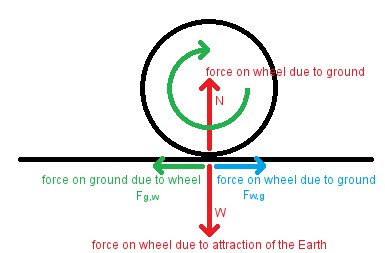I'm attempting to write a little vehicle simulator and I'm working on calculating vehicle linear acceleration and tire angular acceleration. I'm trying to add in tire slipping and I'm having trouble deriving the solution. I realized this is because I don't have a complete understanding of how all the forces involved work. Consider this simplified image:
The tire is receiving torque from the engine and brakes (the green rotating arrow). This can be expressed as a linear force by dividing by the tire radius (the green horizontal arrow). Combine this force with the force of the tire and vehicle from gravity (the red arrow pointing down). Intuitively, this combined force is "applied against the ground". What does this mean exactly? I think you break it up into two components, vertical and horizontal, which happen to just correspond to the force from gravity and the linear force calculated from torque, since we're on flat ground. The vertical force is fully opposed (the red arrow pointing up) and the horizontal force "stays as torque" (maybe? I'm not sure how to correctly think about this). In a frictionless situation, the horizontal force gets no opposing force and causes only angular acceleration. When you add in friction, you get an opposing linear force at the point of contact (I think?), equal in magnitude to the horizontal force in the case of static friction and of a fixed magnitude in the case of kinetic friction (the blue horizontal arrow).
Here's where I'm confused: intuitively, the green line "stays as torque" and causes angular acceleration and the blue arrow "stays as linear force" and causes linear acceleration. But I'm pretty sure that intuition is meaningless/wrong and I just don't understand the concepts well. When are we allowed to go back and forth between torque and force? Why am I allowed to treat the green torque arrow as a force arrow for the purposes of friction (or: am I even allowed to do this?)? Why don't the green and blue arrows simply cancel out, resulting in no acceleration/motion?


